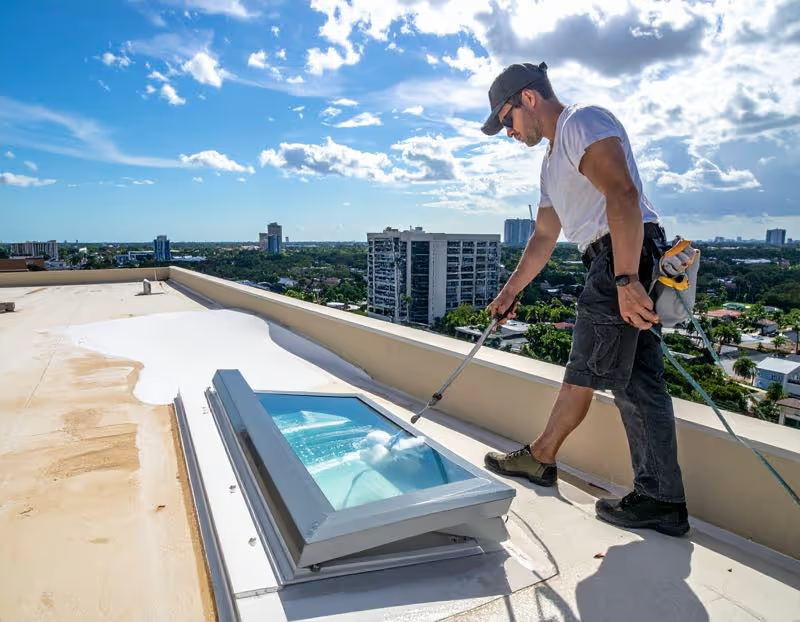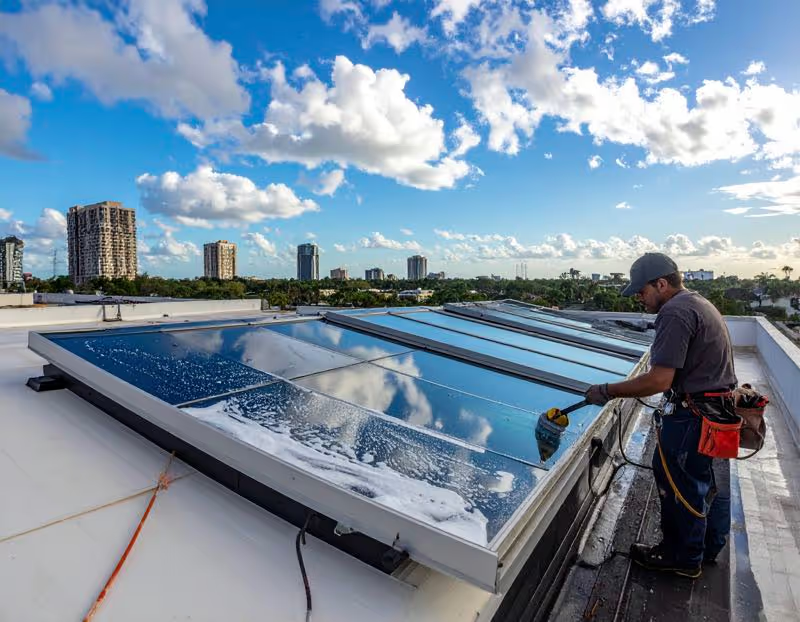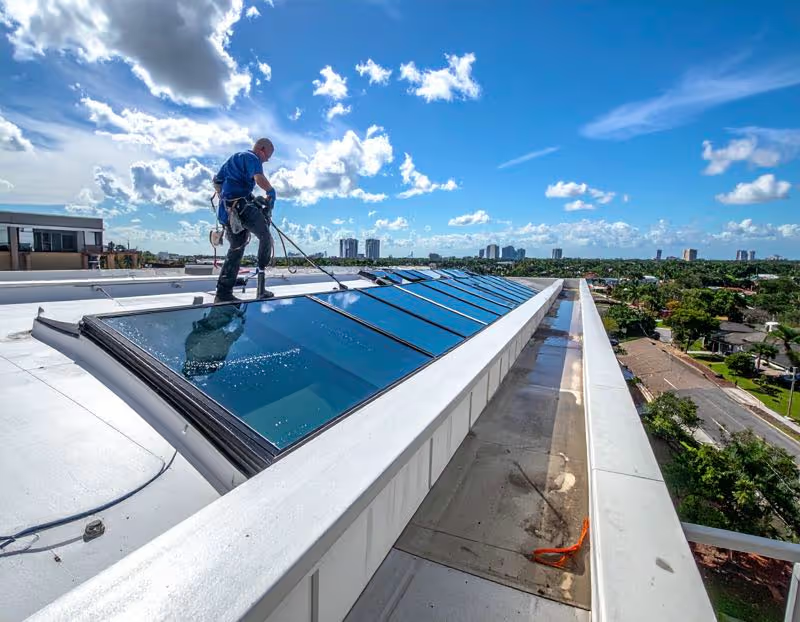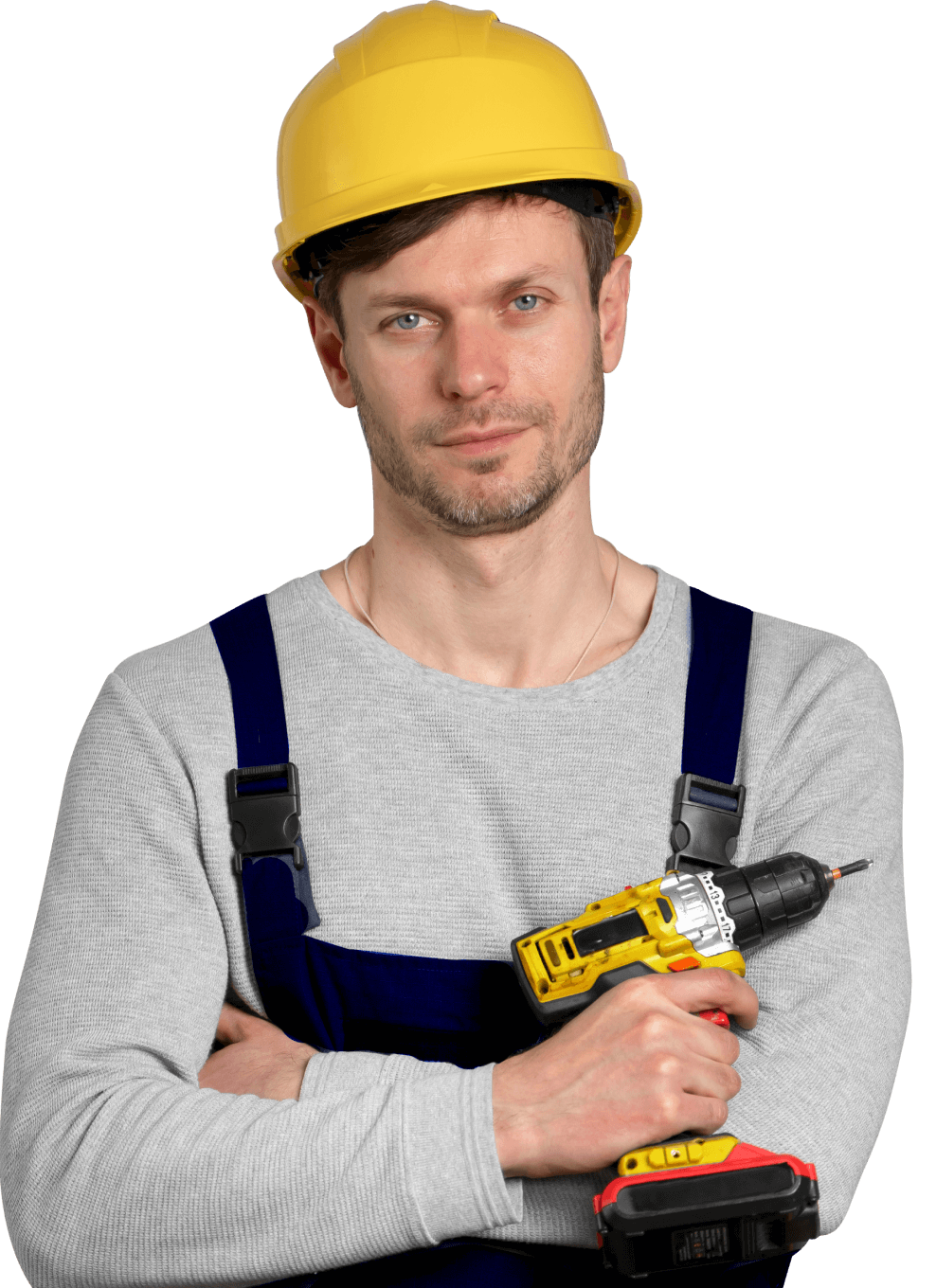
Professional Rooftop Skylight Cleaning in Orlando – Restore Clarity & Prevent Leaks
Keep your skylights crystal clear and leak-free with professional cleaning that removes Florida's stubborn water spots, pollen buildup, and algae stains while inspecting seals to protect your home from moisture damage.
Skylights Need Cleaning Every 6–12 Months in High-Humidity Climates
Your skylights probably need cleaning more often than you think. In Orlando's climate, six to twelve months is the maximum time between cleanings if you want to keep getting the light you paid for.
Homeowners in Winter Park and Lake Nona tell us they notice their rooms getting darker during rainy season. They think it's just the weather. Then we clean their skylights and they're shocked at how much brighter everything looks. We've measured the difference—clean skylights let in 30 to 40 percent more light than dirty ones.
Commercial properties face the same issue. Warehouses and atriums with skylight arrays need quarterly cleaning, especially after pollen season runs from March through May. One property manager in MetroWest told us his electricity bills dropped after we started cleaning his skylights regularly. More natural light meant less time running the lights.
Orlando gets over 50 inches of rain each year. That constant moisture, combined with humidity that stays above 70 percent most of the time, creates perfect conditions for mildew growth on skylight glass. The grime doesn't just sit on the surface. It etches into the glass if you leave it too long. At that point, even professional cleaning can't restore full clarity.
We've seen skylights that were neglected for three or four years. The damage was permanent. The homeowner had to replace skylights that could have lasted another decade with proper maintenance.
Think about how you clean your car windshield. You wouldn't drive for a year without cleaning it, right? Your skylights deserve the same attention. They're exposed to everything your windshield sees, plus they're horizontal surfaces that collect debris your windows never touch.


Professional Cleaning Prevents Seal Damage and Extends Skylight Lifespan
I learned this lesson the hard way early in my career. A homeowner in College Park called us because water was dripping from her skylight during a storm. The skylight itself was only ten years old. When I got up on the roof, I found the problem immediately—someone had pressure washed the skylight at too high a setting and blown out the rubber seal.
The seal damage happened months before the leak started. Water slowly worked its way past the compromised seal until heavy rain finally pushed through. By then, the ceiling below had water stains and the attic insulation was soaked. A $200 cleaning mistake turned into a $3,000 repair.
Older homes in College Park often have original skylights from the 1980s and 1990s. These units were built tough, but their rubber seals show their age. When we clean these skylights, we use extremely low pressure and inspect every inch of the seal. We're looking for cracks, brittleness, or spots where the seal is pulling away from the frame.
Newer construction in Baldwin Park comes with skylights that carry 20-year warranties. The manufacturers require maintenance documentation to keep those warranties valid. They specifically state that improper cleaning voids coverage. We provide written documentation after every service showing we used manufacturer-approved methods and pressures.
Florida's UV exposure destroys skylight seals faster than it would up north. The combination of intense sun and high humidity breaks down rubber and silicone. Proper cleaning extends your replacement timeline by three to five years. That's significant when replacement costs run $800 to $2,000 per skylight.
During cleaning, we check the flashing around the skylight base. Flashing issues cause more leaks than seal problems, but people rarely look at it. Leaves and debris pile up in the flashing channels and hold moisture against the metal. Over time, this causes rust or corrosion. Whether handling residential properties or commercial gutter cleaning, we clear these channels as part of every rooftop skylight cleaning in Orlando.
Unreachable Skylights Require Ladder Stabilization and Low-Pressure Techniques
Two-story homes in Dr. Phillips present a common challenge. Cathedral ceilings put skylights 18 to 25 feet above the roof surface. You can't reach them with a standard ladder, and even if you could, working at that height on a sloped tile roof is dangerous.
We use extension poles with soft-bristle brushes that reach up to 40 feet. These poles are water-fed, meaning cleaning solution flows through the pole to the brush head. We can scrub the entire skylight surface while standing safely on the roof deck. No ladders, no reaching, no risk of falling.
Commercial buildings in MetroWest often have rooftop skylights that are completely inaccessible from inside. Some are positioned over stairwells or elevator shafts. The only way to reach them is from the roof itself. We use roof anchors and safety harnesses when working on steep pitches or near roof edges.
Orlando tile roofs require special care. If you walk directly on the tiles, you'll crack them. Each broken tile costs $15 to $30 to replace, plus labor. We use walk boards—essentially temporary platforms that distribute weight across multiple tiles. This protects your roof while we access the skylights.
Summer rooftop work in Orlando is brutal. Surface temperatures on tile roofs can exceed 160 degrees Fahrenheit. We schedule these jobs before 10 AM or after 4 PM when possible. Heat exhaustion is a real risk, and quality work suffers when technicians are fighting the heat.
Professional equipment makes the difference between a thorough cleaning and a dangerous attempt. I've had homeowners tell me they considered doing it themselves, then realized they didn't have safe access to their own skylights. According to the Occupational Safety and Health Administration, falls from ladders and roofs are among the leading causes of workplace and home injuries, making professional service with proper safety equipment the smart choice for elevated skylight cleaning. That's not a situation where DIY makes sense.
Domed Skylights Collect More Debris During Florida's Hurricane Season
Properties in Windermere with acrylic bubble skylights face unique challenges. The curved surface that makes these skylights attractive also makes them debris magnets. After tropical storms, we find oak leaves, Spanish moss, and pine needles packed into the curved edges where the dome meets the frame.
Pool enclosure skylights in Waterford Lakes accumulate pine needles year-round. The trees that provide shade also drop debris constantly. Curved surfaces catch and hold this material in ways flat skylights don't. The pine needles wedge into crevices and decompose slowly, creating acidic compounds that etch the acrylic.
Hurricane season runs from June through November. Every tropical system that passes through Central Florida deposits heavy debris on roofs. Skylights act as collection points. Water flowing across the roof during heavy rain carries leaves, twigs, and organic matter. This debris piles up against the skylight's uphill edge.
If you don't remove this debris quickly, it creates problems beyond just blocking light. The organic material holds moisture against the skylight frame. This constant dampness accelerates seal degradation and can cause the mounting flange to rust. We've seen cases where debris piles actually displaced the flashing around the skylight base.
Cleaning domed skylights requires specialized tools. Standard squeegees don't work on curved surfaces. We use soft foam applicators that conform to the dome shape. These applicators clean without scratching, which is critical for acrylic skylights. Even minor scratches catch dirt and make future cleaning harder.
The debris that accumulates around skylights eventually washes into your gutters. If your gutters are already full, the debris has nowhere to go. It backs up onto the roof and creates standing water. This is how skylight cleaning and gutter cleaning work together. We often recommend doing both services at the same time, especially right before or after hurricane season.
Algae and Mold Grow Faster on Skylights in Shaded Roof Sections
Homes near Lake Eola with mature tree canopy face this issue constantly. North-facing skylights, which get the least direct sun, develop green and black streaking within months of cleaning. The streaks aren't just dirt—they're living organisms feeding on moisture and organic matter.
Apartments in downtown Orlando with limited sun exposure show the problem even faster. We've seen fuzzy mold layers develop within six months on skylights that barely see direct sunlight. The mold isn't just ugly—it etches the glass and reduces light transmission by up to 50 percent.
Subtropical moisture combined with tree cover creates ideal conditions for biological growth. Skylights under oak trees in established Orlando neighborhoods need cleaning twice per year minimum. Once per year isn't enough. The algae and mold come back too quickly.
Standard cleaning removes the visible growth, but it doesn't kill the spores. Within weeks, the streaking returns. That's why we use biocide treatments on skylights in shaded locations. The treatment kills spores at the root level and prevents regrowth for eight to twelve months.
The type of tree matters. Live oaks drop tannins that stain skylight glass brown. These tannins bond to the glass surface chemically. Water alone won't remove them. We use specialized surfactants that break the tannin bonds without damaging the glass or seals.
Pine trees present a different challenge. Pine pollen is incredibly fine and sticky. During pollen season in early spring, a yellow film covers everything. This film is hydrophobic—it repels water. Standard cleaning methods just push it around. We use degreasing agents that break down the pollen's waxy coating first, then rinse thoroughly.
Shaded skylights also collect more humidity condensation. In the early morning, when temperatures drop, moisture condenses on the cooler glass surface. This daily moisture cycle feeds biological growth. There's not much you can do about the condensation itself, but regular cleaning with biocide treatment keeps the growth under control.
Vinegar Solutions Work for Light Cleaning but Miss Embedded Grime
Homeowners in Audubon Park often try DIY cleaning first. The internet tells them vinegar is the solution for everything. They spray vinegar on their skylights, scrub with a sponge, and rinse. The skylight looks better, but a hazy film remains after it dries.
Property managers try these budget methods before calling professionals. I understand the impulse—why spend money if a simple solution works? The problem is, vinegar can't handle Orlando's specific challenges.
Vinegar is acetic acid. It works well on light dust and some mineral deposits. But Orlando's hard water measures 150 to 250 parts per million of dissolved minerals. Our afternoon thunderstorms hit almost daily during summer. Each storm deposits a thin layer of minerals on your skylight. Over months, these layers build up into a cloudy film that vinegar alone cannot dissolve.
Professional-grade surfactants break down oxidation and mineral deposits that acidic cleaners miss. These surfactants change the surface tension of water, allowing it to penetrate and lift grime that's bonded to the glass. The chemicals we use are pH-neutral, which means they won't damage seals or frames.
Commercial equipment makes a significant difference too. Our water-fed poles deliver cleaning solution at precise pressures while scrubbing brushes agitate the surface. We can reach every angle and corner of the skylight, including the edges where grime accumulates most heavily.
The other issue with DIY cleaning is access. Most homeowners can't safely reach their own skylights. They end up cleaning from inside, which only addresses half the problem. The exterior surface—the side exposed to weather, pollen, and debris—stays dirty. Interior cleaning helps with fingerprints and dust, but it doesn't restore the light transmission you've lost.
We've had customers tell us they spent hours on DIY cleaning and still weren't satisfied with the results. Then we cleaned their skylights properly and they finally saw what clean actually looks like. The difference isn't subtle. It's dramatic enough that they notice it every time they walk into the room.
Frequently Asked Questions
Can you pressure wash a skylight in Orlando without cracking it?
Yes, but only if you use the right pressure settings. Acrylic domes require pressure under 500 PSI. Tempered glass skylights can handle up to 1,200 PSI. Higher pressure damages seals and causes cloudiness in acrylic. Most pressure washers run at 3,000 PSI or higher, which is why skylight cleaning requires specialized equipment and training.
How often should skylights be cleaned in Florida's humid climate?
Every six months at minimum. Properties near lakes or with heavy tree cover need quarterly cleaning to prevent algae buildup. If your skylights face north or spend most of the day in shade, you might need cleaning every four months. The investment pays off in maintained light levels and extended skylight life.
Do self-cleaning skylights still need manual cleaning in Orlando?
Yes. Hydrophobic coatings reduce daily grime accumulation, but they don't eliminate pollen, oak tannins, or mildew. Central Florida's environmental conditions overwhelm self-cleaning technology within months. We clean self-cleaning skylights the same way we clean standard ones—the coating just means the skylights don't get quite as dirty between services.
What's the most common skylight problem after Orlando storms?
Debris-clogged flashing and cracked seals. Both issues allow water intrusion that causes interior ceiling stains and attic mold. After every major storm, we get calls from homeowners who suddenly have leaking skylights. The storm didn't break the skylight—it exposed existing problems that went unnoticed. Post-storm inspections catch these issues before they cause interior damage.
How do you clean unreachable skylights on two-story Orlando homes?
Water-fed poles with soft-bristle brushes reach up to 40 feet. This eliminates ladder setup on tile roofs that crack under weight. The poles deliver cleaning solution directly to the brush head while we control it from roof level or ground level. For extremely high or difficult-access skylights, we use lift equipment, but poles handle most residential situations safely and efficiently.
Does rooftop skylight cleaning include frame and gutter inspection?
Yes. Our full service checks surrounding roof tiles for damage, clears debris from nearby gutters, and tests seal integrity before we leave your property. We photograph any issues we find and discuss them with you immediately. Most problems are minor and easily fixed when caught early. We'd rather tell you about a cracked seal now than get a call about a leak six months from now.
Ready to restore your skylight clarity? Pressure Washing Guys serves Orlando and Central Florida with professional rooftop skylight cleaning that's safe for your home and backed by our satisfaction guarantee. We're licensed, insured, and experienced in handling skylights of all types—from standard flat glass to delicate acrylic domes.
Call us at (407) 412-4015 or visit pressurewashingguysflorida.com to schedule your skylight cleaning. Same-day service available in most Orlando neighborhoods.
Pressure Washing Guys
5295 Creekside Park Ave
Orlando, FL 32811


Get a quote within an hour for your project!
Our team responds fast so you can start your project
without delays or guesswork.

